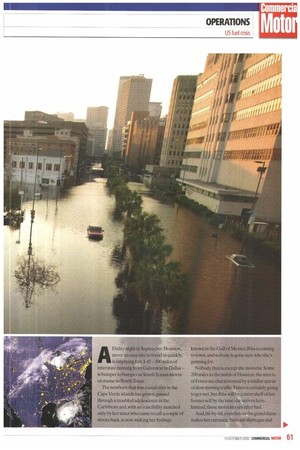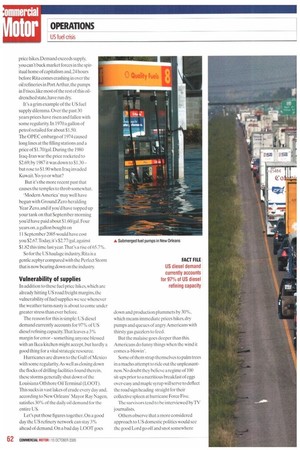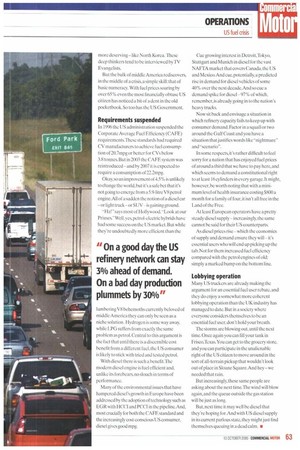A Friday night in September. Houston, never an easy city to
Page 63

Page 64

Page 65

If you've noticed an error in this article please click here to report it so we can fix it.
travel in quickly, is emptying fast.1-45 —300 miles of interstate running from Galveston to Dallas — is bumper to bumper as Soul h 'Texans moves en masse to North Texas.
The newborn that was cooed over in the Cape Verde islands has grown,passed through a troubled adolescence in the Caribbean and, with an irascibility matched only by her sister who came to call a couple of weeks back, is now making her feelings known in the Gulf of Mexico. Rita is coming to town, and nobody is quite sure who she's gunning for.
Nobody, that is, except the motorist. Some 200 miles to the north of Houston, the streets of Frisco are characterised by a similar queue of slow moving traffic. Frisco is certainly going to get wet, but Rita will be a mere shell of her former self by the time she arrives here. Instead, these motorists are after fuel.
And,bit-by-bit.even before the grand dame makes her entrance,there are shortages and price hikes. Demand exceeds supply, you can't buck market forces in the spiritual home of capitalism and,24 hours before Rita comes crashing in over the oil refineries in Port Arthur, the pumps in Frisco,like most of the rest of this oildrenched state, have run dry.
It's a grim example of the US fuel supply dilemma. Over the past 30 years prices have risen and fallen with some regularity. In 1970 a gallon of petrol retailed for about $1.50.
The OPEC embargo of 1974 caused long lines at the filling stations and a price of $1.70/gal. During the 1980 Iraq-Iran war the price rocketed to $2.69; by 1987 it was down to $1.30— hut rose to $1.90 when Iraq invaded Kuwait.Yo-yo or what?
But it's the more recent past that causes the temples to throb somewhat.
'Modern America' may well have begun with Ground Zero heralding Year Zero, and if you'd have topped up your tank on that September morning you'd have paid about $1.60/gal. Four years on, a gallon bought on 11 September 2005 would have cost you $2.67.Today, it's $2.77/gal, against $1.82 this time last year.That's a rise of 65.7%.
So for the US haulage industry. Rita is a gentle zephyr compared with the Perfect Storm that is now bearing down on the industry.
Vulnerability of supplies
In addition to these fuel price hikes, which are already hitting US road freight margins, the vulnerability of fuel supplies we see whenever the weather turns nasty is about to come under greater stress than ever before.
The reason for this is simple: US diesel demand currently accounts for 97% of US diesel refining capacity.That leaves a 3% margin for error —something anyone blessed with an Ikea kitchen might accept, but hardly a good thing for a vital strategic resource.
Hurricanes are drawn to the Gulf of Mexico with some regularity. As well as closing down the flocks of drilling facilities found therein, these storms generally shut down of the Louisiana Offshore Oil Terminal (LOOT). This sucks in vast lakes of crude every day and, according to New Orleans' Mayor Ray Nagen, satisfies 30% of the daily oil demand for the entire US.
Let's put those figures together. On a good day the US refinery network can stay 3% ahead of demand. On a bad day LOOT goes down and production plummets by 30%, which means immediate prices hikes, dry pumps and queues of angry Americans with thirsty gas guzzlers to feed.
But the malaise goes deeper than this. Americans do funny things when the wind it comes a-blowin'.
Some of them strap themselves to palm trees in a macho attempt to ride out the unpleasantness.No doubt they believe a regime of 100 sit-ups prior to a nutritious breakfast of eggs over-easy and maple syrup will serve to deflect the road sign heading straight for their collective spleen at hurricane Force Five.
The survivors tend to be interviewed by TV journalists.
Others observe that a more considered approach to US domestic politics would see the good Lord go off and snot somewhere more deserving—like North Korea. These deep thinkers tend to be interviewed by TV Evangelists.
But the bulk of middle America rediscovers, in the middle of a crisis, a simple skill: that of basic numeracy. With fuel prices soaring by over 65% even the most financially obtuse US citizen has noticed a bit of a dent in the old pocketbook. So too has the US Government.
Requirements suspended In 1996 the US administration suspended the Corporate Average Fuel Efficiency (CAFE) requirements.These standards had required CV manufacturers to achieve fuel consumption of 20.7mpg or better for CVs below 3.8 tonnes. But in 2003 the CAFE system was reintroduced— and by 2007 it is expected to require a consumption of 22.2mpg.
Okay, so an improvement of 4.5% is unlikely to change the world,but it's a safe bet that it's not going to emerge from a 5.9-litre V8 petrol engine.All of a sudden the notion of a diesel car —or light truck—or SUV— is gaining ground.
-Ha!" says most of Hollywood. "Look at our Priuses." Well, yes, petrol-electric hybrids have had some success on the US market. But while they're undoubtedly more efficient than the lumbering V8 behemoths currently beloved of middle America they can only be seen as a niche solution. Hydrogen is some way away, while LPG suffers from exactly the same problem as petrol. Central to this argument is the fact that until there is a discernible cost benefit from a different fuel, the US consumer is likely to stick with tried and tested petrol.
With diesel there is such a benefitrlhe modem diesel engine is fuel efficient and, unlike its forebears, no slouch in terms of performance.
Many of the environmental issues that have hampered diesel's growth in Europe have been addressed by the adoption of technology such as EGR with HCCI and PCCI in the pipeline. And, most crucially for both the CAFE standard and the increasingly cast-conscious US consumer, diesel gives good mpg. Cue growing interest in Detroit,Tokyo, Stuttgart and Munich in diesel for the vast NAFTA market that covers Canada, the US and Mexico. And cue, po tentially, a predicted rise in demand for diesel vehicles of some 40% over the next decade. And so cue a demand spike for diesel — 97% of which, remember, is already going in to the nation's heavy trucks Now sit back and envisage a situation in which refinery capacity fails to keep up with consumer demand. Factor in a squall or two around the Gulf Coast and you have a situation that justifies words like "nightmare" and"scenario".
In some respects, it's rather difficult to feel sorry for a nation that has enjoyed fuel prices of around a third that we have to pay here, and which seems to demand a constitutional right to at least 16 cylinders in every garage. It might, however, be worth noting that with a minimum level of health insurance costing $800 a month for a family of four, it isn't all free in the Land of the Free.
At least European operators have a pretty steady diesel supply — i ncreasingly, the same cannot be said for their US counterparts.
As diesel prices rise —which the economics of supply and demand ensure they will —it's essential users who will end up picking up the tab. Not for them increased fuel efficiency compared with the petrol engines of old; simply a marked bump on the bottom line.
Lobbying operation Many t IS truckers are already making the argument for an essential fuel user rebate, and they do enjoy a somewhat more coherent lobbying operation than the UK industry has managed to date. But in a society where everyone considers themselves to be an essential fuel user, don't hold your breath.
The storms are blowing out, until the next time. Once again you can au your tank in Erisco,Texas.You can get to the grocery store, and you can participate in the unalienable right of the US citizen to move around in the sort of all-terrain pickup that wouldn't look out of place in Sloane Square. And hey—we needed that rain.
But increasingly, these same people are asking about the next time. The wind will blow again, and the queue outside the gas station will be just as long.
But, next time it may well be diesel that they're hoping for. And with US diesel supply in its current parlous state, they might just find themselves queuing in a dead calm. •












































































































































































































